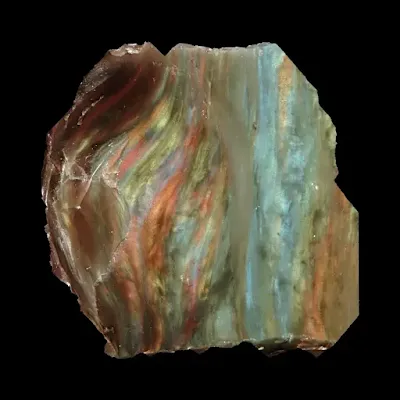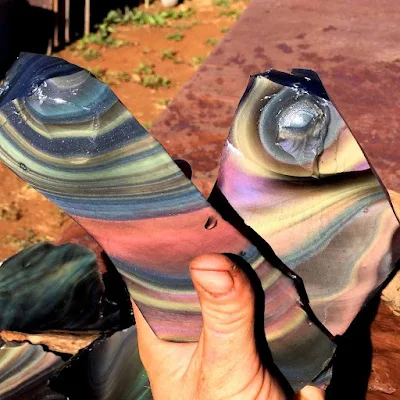Rainbow Obsidian: Iridescent Obsidian
Rainbow obsidian is a variety of natural volcanic glass known for its iridescent sheen, which displays a spectrum of colors when light reflects off it. This colorful display is primarily due to the diffraction of light caused by nanoscale inclusions or structural features within the glass. These effects become particularly noticeable when the obsidian is cut and polished, enhancing the visibility of its internal light play.
Rainbow obsidian showcases a captivating spectrum of colors, typically including vibrant greens, purples, reds, and golds. The specific colors and their intensity can vary depending on the size and distribution of magnetite inclusions within the stone.
Obsidian is a naturally occurring volcanic glass. It is formed during the eruption of felsic lavas, which are distinguished by having high concentrations of the chemical element silica. Because of their high silica content, felsic lavas do not behave like the mafic, or silica-poor, lavas we see on the island of Hawaii.
The colors displayed in rainbow obsidian are influenced by the size, shape, and arrangement of microscopic or nanoscopic inclusions or structural features within the glass. These factors determine how light is diffracted or interferes with itself, producing iridescence. While the material composition of these inclusions can influence the overall appearance, the specific colors of iridescence are primarily a result of light interaction rather than the direct color of the inclusions themselves.
 |
Polished Rainbow Obsidian. Photo: La Roche Mère |
Formation of Rainbow Obsidian
Rapid Cooling: It all starts with molten lava, typically rich in silica (felsic lava). When this lava encounters a sudden temperature drop, like contact with water or air, it cools down extremely quickly. This rapid cooling prevents the formation of regular crystals, resulting in a glassy rock – obsidian.
Microscopic Inclusions: During this rapid cooling, tiny mineral inclusions, often magnetite nanoparticles, can become trapped within the solidifying obsidian. These inclusions are usually less than 0.01 millimeter in size and often arranged in a specific pattern.
Properties of Rainbow Obsidian
Color: Rainbow obsidian's defining characteristic is its play of color, exhibiting vibrant flashes of red, green, blue, violet, and gold depending on the light and viewing angle. This iridescence is caused by the presence of tiny gas bubbles and mineral inclusions, primarily magnetite, within the obsidian.
Luster: Rainbow obsidian typically has a vitreous luster, meaning it has a glassy, shiny appearance. The iridescence adds a unique, almost metallic quality to its luster.
Transparency: Rainbow obsidian is typically opaque, meaning light cannot pass through it. However, some thinner pieces might exhibit a slight translucency at the edges.
Texture: Rainbow obsidian is typically opaque and smooth to the touch, with a conchoidal fracture when broken, meaning it breaks into sharp, curved fragments.
Hardness: Like all obsidian, rainbow obsidian is a relatively hard stone, ranking 5-6 on the Mohs scale of mineral hardness. This means it can scratch many other materials but can be scratched itself by harder minerals like quartz.
Mineral composition: Rainbow obsidian is not a single mineral but a volcanic glass composed primarily of amorphous silica (SiO₂). However, the presence of gas bubbles and other mineral inclusions, such as magnetite, contribute to its unique properties and play of color.
Density: Rainbow obsidian is a relatively dense stone, with a density of 2.4-2.6 g/cm3. This means it feels heavier than many other common rocks of similar size.
Magnetism: Due to the presence of magnetite inclusions, rainbow obsidian is weakly magnetic. However, this magnetism is not strong enough to attract most other magnets.
Specific Gravity: Specific gravity refers to the density of a substance compared to the density of water. Rainbow obsidian's specific gravity ranges from 2.4 to 2.7, meaning it is 2.4 to 2.7 times heavier than water.
Fracture: Rainbow obsidian exhibits a conchoidal fracture, meaning it breaks into sharp, irregular fragments with curved edges. This characteristic makes it unsuitable for applications requiring high durability or impact resistance.
Refractive Index: The refractive index of rainbow obsidian varies slightly depending on its specific composition, typically ranging between 1.48 and 1.55. This property influences how light interacts with the stone and contributes to its shimmering appearance.
 |
| Raw California Rainbow Obsidian! |
What Causes the Color of Rainbow Obsidian
The color of rainbow obsidian is caused by the presence of tiny inclusions of magnetite, which refract light in different directions. These inclusions are typically less than 0.01 millimeter in size and are arranged in a regular pattern. When light hits the inclusions, it is scattered in all directions, creating the iridescent sheen that is characteristic of rainbow obsidian.
The iridescence of rainbow obsidian is a result of a phenomenon called thin-film interference. Thin-film interference is a phenomenon that occurs when light passes through a thin layer of material. The light waves are reflected off of the top and bottom surfaces of the layer, and the waves interfere with each other. This interference can produce a variety of colors, depending on the thickness of the layer and the wavelength of the light.
In the case of rainbow obsidian, the thin layers are created by the magnetite inclusions. The magnetite inclusions are less dense than the surrounding glass, so they cause the light to bend as it passes through them. This bending creates the thin layers that are responsible for the iridescence.
 |
| Velvet rainbow obsidian from the Cenozoic of Mexico. Photo: James St. John |
Where is Rainbow Obsidian found
Here are some specific places where you might encounter this mesmerizing gem:
California:
While there are a few scattered deposits around the world, the vast majority of rainbow obsidian is found in the Warner Mountains of northeastern California, USA. More specifically, it's concentrated in the Modoc National Forest, near the Oregon border. Within this region, there are four main mines known for their rainbow obsidian:
- Pink Lady Mine: This mine is famous for its pink obsidian, but it also produces some beautiful rainbow specimens.
- Lassen Creek Rainbow Mine: As the name suggests, this mine is known for its high-quality rainbow obsidian with vibrant colors.
- Needles Mine: This mine is unique for its deposits of elongated obsidian needles, some of which exhibit the rainbow effect.
- Middle Fork Davis Creek Mine: This mine offers a variety of obsidian, including rainbow obsidian with multiple color flashes.
Mexico: Several areas in Mexico, particularly Chihuahua and Jalisco, are known for producing high-quality rainbow obsidian. Local markets and artisans often offer unique pieces, but be cautious about authenticity and ethical sourcing practices.
Guatemala: Certain regions in Guatemala, like Lake Atitlán, are known for their rainbow obsidian deposits. Indigenous communities often craft beautiful jewelry and carvings from this stone, offering a chance to connect with local culture and support artisanal practices.
Armenia: The Garni Gorge in Armenia is another source of rainbow obsidian, with some shops and artisans in the area offering unique pieces. Research responsible sourcing practices and ensure you're buying from reputable vendors.
Iceland: While less common, rainbow obsidian can also be found in certain parts of Iceland, particularly in volcanic regions. Visiting specialized shops or connecting with local gem enthusiasts might lead you to this rare treasure.
Rainbow Obsidian FAQs
Is Rainbow Obsidian expensive
The price of Rainbow Obsidian can vary significantly depending on its quality, size, and color intensity. High-quality stones with vivid colors and large sizes can fetch higher prices. However, compared to other precious gemstones, Rainbow Obsidian is generally considered relatively affordable.
Is rainbow obsidian real or fake
Rainbow obsidian is a naturally occurring variety of obsidian. While some stones might be treated to enhance their color, genuine rainbow obsidian exhibits its iridescent sheen due to its inherent mineral composition and structure.
 |
| Rainbow Obsidian, from Davis Creek, California |
How can you tell if rainbow obsidian is real
The most reliable way to authenticate rainbow obsidian is through gemological testing. However, some visual clues can also be helpful. Genuine rainbow obsidian will typically display:
Natural color variation: The colors appear organic and blend smoothly, not uniform or concentrated in specific areas.
Surface texture: The stone should be smooth and glassy, not overly polished or treated with artificial coatings.
Depth of color: The iridescent sheen should appear to come from within the stone, not just a surface layer.
 |
| Rainbow Obsidian - California |
Conclusion
Rainbow obsidian is a relatively rare gemstone, found in limited locations around the world. Its beauty and unique properties make it a prized possession for collectors, jewelry makers, and anyone who appreciates the wonders of nature.
Read also:
Mahogany Obsidian - Properties, Uses, Red Obsidian
Snowflake Obsidian








